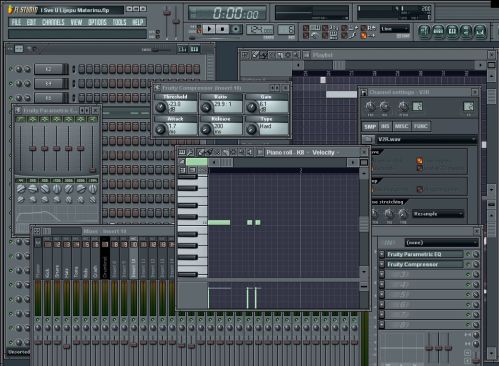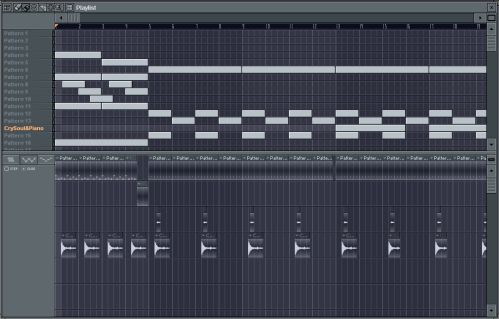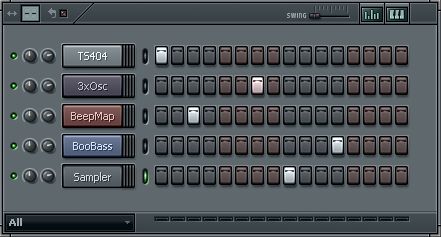What program should I use to record and mix music? I mean, I am not some genius musician nor am I a keen programmer, I just want to…….errr……..you know, make music.
Today, when professional studios almost single-handedly support the dominion of a few mainstream programs used in “real” and professional studios, it is hard to get an honest answer. Especially, knowing that for years, money has been spent to educate people in using these programs efficiently.
However, not everything is as black as it seems – this time it’s gray and comes by the name Image-Line FL Studio 7 (formerly known as Fruity Loops). Few months ago Image-Line has come out with version 7 of their DAW (Digital Audio Workstation) and it looks better than ever.
Once a simple program, bearing more resemblance to minesweeper than a serious application, FL Studio has grown into one of the main players in the industry. 64bit processing, 32bit floating point rendering (0.24 and 16.8), sampling capabilities way ahead of the mainstream competition, great MIDI support, a number of native plug-ins, piano-roll that threatens to become a standard, Rewire support, plug-in version of the program, and many more advantages – put FL Studio right in the big leagues.
The recently published 7th version saw a couple more improvements like mono recording (R or L), new pitch-shifting and time-stretching algorithms, 64 track simultaneous recording and more. It appears that the only thing fruity about Fruity is its name.

However, although it does not lag behind the main advantage of FL Studio does not lie in technical specifications; its advantage lies within its simplicity. Most modern DAWs have quite a sharp learning curve, which to most musicians and music enthusiasts, presents a great deal of trouble. FL Studio is one of few (if any) programs that let you create music within minutes upon installation. It’s intuitive and user-friendly interface simply begs to be played with. Huge colorful interfaces that often confuse a user will not find a home in FL.
Its interface is sleek and, at a first glance, quite simplistic. If you crave more options, they’re just a click away - carefully and intuitively placed in order not to confuse or scare users! It is so music orientated that you often forget it’s a program - in fact, it is more like an instrument first, and program second. However, if you think its simplicity reflects the quality in a negative manner, you’re in for a big surprise – because the only limit in FL Studio is the limit of your imagination.
FL Studio is a so-called pattern-based sequencer. What it means is that you assemble a composition out of pre-made patterns. Patterns are created in a step-sequencer, which is quite simple to use, in fact, it is one part of FL Studio that in a way still resembles minesweeper. The left part of the step-sequencer contains samples while the right part contains steps. Individual sample properties are easily accessible by a simple click on the desired sample. Individual properties contain everything a sample might need: re-sampling, disk reading (in order to save RAM), envelopes (volume, cut, resonance, etc), time stretching methods, etc.
After creation of one or more patterns, they are arranged into the playlist. Playlist itself is simple as well – left button draws, right button erases. In the lower part of the playlist window is the wave window, where you can add and manipulate wave files. A significant improvement in the latest version is the possibility to arrange patterns in the wave window where they can be edited and manipulated like wave files in order to obtain more creative freedom.

The mixing process is excellently handled by the program’s internal mixer containing 64 mono/stereo channels and four send channels. If four sends is not enough, that’s not a problem – this version allows users to create sends from any available channel with a simple click. This also helps if eight effects per channel is not enough – simply route the track into another free track and problem’s solved.
Trough years on the scene, FL Studio has developed a strong fan-base, and although many of them are Trance music fans and authors, FL users are not exclusive to Trance. Famous, or as Image-Line calls them, Power-users range from 9th Wonder, DJ and band’s “Little Wonder” producer, Steve Duda, famous for working with authors such as NIN, Rob Zombie, Methods Of Mayhem, Pitchshifter and Perfect Circle, to Mark Tinley, sound engineer and producer famous for his work with Duran Duran, Gary Numan, The Stranglers etc., and English musical genius Mike Oldfield, who (I hope) needs no introduction. As a reason to why they’re using FL Studio, each of this users points their finger to simplicity of use that does not sacrifice the quality.
It is interesting to note how the whole program, from first to last version, has been developed by one man – Didier Dambrin. Starting in 1998, because as he says: “at that time there were only two programs that were interesting (read fun to use)”, he leads the developer team. Actually, if we’re talking about the program itself, he IS the developer team – newer plug-ins are developed by people who: “are best at what they do!” Those were hand-picked by Didier for their work on quality, and mostly freeware, plug-ins.

Interestingly enough, when asked about difficulties with programming, he points all fingers to Windows programming, due to his previous work that was mostly done in Borland’s Turbo Pascal (today known as Inprise Delphi). When asked about the main advantage of FL Studio he points to the interface.
Let us now discuss, what is for us mere mortals, one of the most important qualities – price! Fl Studio comes in few versions: Express, Fruity Loops Edition, Producer Edition and XXL Edition (available boxed or for download). Here is a list of prices and options each version offers:
| Download | Kutija | o | |
| FL Studio XXL | $361 |
$449 |
· All Producer Edition features and... · DirectWave Sampler Plugin · Sytrus Generator Plugin · SimSynth Live Generator Plugin · DX10 FMSynth Generator Plugin · SoundFont Player Generator Plugin · DrumSynth Live Generator Plugin · Video Player Plugin |
|
FL Studio Producer Edition |
$149 |
$209 |
· All Fruityloops Edition features and... · Audio tracks with waveform preview & support for cue points. · Automation clips with spline-based envelopes and an LFO unit. · Direct-to-disk recording & offline rendering of mixer tracks. · Integrated Wave Editor. |
| FL Studio Fruityloops Edition | $99 | $139 | · All Express Edition features and... · Piano roll allowing chords. · Full automation of all wheels. · ASIO support (allowing 2ms latency!). · Internal controllers. · Can be used as VSTi client in hosts like Cubase, Sonar, |
| FL Studio Express | $49 | - | · Mixer Window (64 channels, track rerouting, ASIO track recording, integrated EQ and more). · External generators. · 16Bit 44KHz stereo. · External midi control · Unlimited number of channels · 4 to 64 notes in a pattern sequencer. · Integrated TS-404 bassline. · Support for VSTi & DXi. · Export to wav, MP3 & MIDI. · Playlist. · Piano keyboard. |
What will strike any user as a most-convenient feature is life-time upgrades – which means you pay for this program only once, each future version (of the same category of course) is yours for free. Today when companies race each other in coming out with newer versions, this brings great relief to an end-users pocket.
Conclusion
In the end, FL Studio might not be the most advanced DAW, but it does not lag behind. It might not be endorsed by professional studios, but you can use it as a plug-in in every “professional” program. What it definitely is – is simple and fun to use, whether you are an enthusiast or a producer not willing to sacrifice quality.

Price/quality ratio is almost comical and totally aimed at a user. And finally, if all these advantages, benefits and options are not enough to turn you into an FL Studio user – then heads up and wait for a couple of years more, because FL is definitely here to stay. We can recommend this nice piece of audio recording software.

